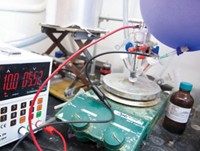Advertisement
Grab your lab coat. Let's get started
Welcome!
Welcome!
Create an account below to get 6 C&EN articles per month, receive newsletters and more - all free.
It seems this is your first time logging in online. Please enter the following information to continue.
As an ACS member you automatically get access to this site. All we need is few more details to create your reading experience.
Not you? Sign in with a different account.
Not you? Sign in with a different account.
ERROR 1
ERROR 1
ERROR 2
ERROR 2
ERROR 2
ERROR 2
ERROR 2
Password and Confirm password must match.
If you have an ACS member number, please enter it here so we can link this account to your membership. (optional)
ERROR 2
ACS values your privacy. By submitting your information, you are gaining access to C&EN and subscribing to our weekly newsletter. We use the information you provide to make your reading experience better, and we will never sell your data to third party members.
Synthesis
Chemists Present Innovative Methods For Reducing Alkenes And Coupling Them Directly
Organic Chemistry: First-row transition-metal-catalyzed processes build motifs in medicinally active molecules
by Carmen Drahl
January 17, 2014
| A version of this story appeared in
Volume 92, Issue 3
Alkenes are incredibly common in the molecular world, so researchers constantly seek more ways to use them in chemical transformations. Now, two independent teams have uncovered new alkene reactivity after activating olefins with first-row transition metals. The methods—a selective alkene reduction and a carbon-carbon bond formation—each solve a problem chemists commonly face.
The advances come from the groups of Ryan A. Shenvi and Phil S. Baran, both at Scripps Research Institute California. Both chemistries convert an alkene starting material to a reactive species, explains Erick M. Carreira of ETH Zurich, who has also worked in this area. But from there, he adds, “each brilliantly utilizes the ensuing reactive intermediates in different and innovative ways.”
Shenvi’s group developed an alkene reduction that leads to alkane products with thermodynamically favorable configurations (J. Am. Chem. Soc. 2014, DOI: 10.1021/ja412342g). Alkenes are most often reduced through catalytic hydrogenation, which typically involves delivery of H2 to the same face of the alkene. The resulting products may be more accessible, but they’re not necessarily the more stable reaction product nor the desired one, points out organic chemist Michael J. Krische of the University of Texas, Austin. Reductions with a metal such as lithium dissolved in liquid ammonia provide thermodynamic products but obliterate nearby functional groups.
To get thermodynamic control without the mess, Shenvi’s team avoided the unstable intermediate that dissolving metal reductions produce—radical anions. “If you can in essence add a hydrogen atom to an alkene, your intermediate becomes a carbon radical, which is more stable than a radical anion,” Shenvi explains. To reduce the alkene, his group used a combination of phenylsilane and a manganese catalyst. They added tert-butyl hydroperoxide to their reaction to regenerate the catalyst. The method works on heterocycles frequently seen in drug molecules and also leaves nearby halogen atoms intact. Shenvi’s group is working on an asymmetric version of the chemistry and investigating its mechanism.
Meanwhile, Baran and his group developed their own variation on the alkene activation theme. They coupled unactivated alkenes to electron-poor alkenes directly (J. Am. Chem. Soc. 2014, DOI: 10.1021/ja4117632). The reaction typically takes place in less than one hour in an open flask and can be performed on gram scales. The chemistry generates crowded bicyclic molecules and quaternary centers, which are otherwise hard to construct. “The fact that a simple iron catalyst can be used to promote these transformations makes this method especially attractive,” Krische says.
Baran notes that both his work and that of Shenvi, his former student, build on a rich legacy of olefin functionalization from multiple teams. This field, he says, is poised for a renaissance.
Baran also speculates that the flavor and fragrance industry might be interested in the chemistry. “Some of our products smell really good,” he says.






Join the conversation
Contact the reporter
Submit a Letter to the Editor for publication
Engage with us on Twitter